Ferrari 308 GTB & GTS
|
|
| Manufacturer | Ferrari |
|---|
| Production | 1975–1977 Fiberglass
1977–1985 steel |
|---|
| Assembly | Maranello, Italy |
|---|
| Predecessor | Dino 246 |
|---|
| Successor | Ferrari 328 |
|---|
| Class | Sports car |
|---|
| Body style | Berlinetta
Targa top |
|---|
| Layout | RMR layout |
|---|
| Engine | 3.0 L Tipo F105A V8
3.0 L FI V8 (GTBi/GTSi)
3.0 L 4v V8 (QV) |
|---|
| Transmission | 5-speed manual all-synchromesh |
|---|
| Wheelbase | 94.12 in (2,391 mm) |
|---|
| Length | 166.53 in (4,230 mm) |
|---|
| Width | 67.71 in (1,720 mm) |
|---|
| Height | 44.09 in (1,120 mm) |
|---|
| Related | Ferrari 208/308 GT4
Ferrari Mondial
Ferrari 288 GTO |
|---|
| Designer | Leonardo Fioravanti at Pininfarina |
|---|
The Ferrari 308 GTB (and similar 208 and later 328) are mid-engined sports cars manufactured by the Italian company Ferrari in the 1970s-1980s. They made up the lower end of the company's range. The 308 replaced the Dino 246 in 1975 and was updated as the 328 in 1985.
GTB and GTS
The Pininfarina-styled 308 GTB was introduced at the Paris Motor Show in 1975 as a supplement to the Bertone-shaped Dino 308 GT4 and a replacement for the Dino 246. It was designed by Leonardo Fioravanti who had been responsible for some of Ferrari's most celebrated shapes to date such as the Daytona, the Dino and the Berlinetta Boxer. The 308 used elements of these shapes to create something very much in contrast with the angular GT4 2+2. The GTB/GTS was a 2-seater with sweeping curves and aggressive lines, and has become the most recognized and iconic Ferrari road car.
The targa topped 308 GTS was introduced in 1977 and was made famous on the television series Magnum, P.I.. Several cars were used, a new one for each season, most being auctioned off after filming. The first was a 1979 model with chassis number 28251.
The mechanically similar 308 GT4 shared much with the original Dino, and the 308. Both sit on the same tube-frame platform, with a 92 in (2,300 mm) wheelbase for the 308 GTB (the 308 GT4 has a longer wheelbase, being a
2+2), and 4-wheel double wishboneindependent suspension. The
V8 engine is a DOHC design, with four Weber 40DCNFcarburetors. European versions produced 255 hp (190 kW) at 7,000 rpm (7700 rpm redline), but American versions were down to 240 hp (178 kW) at 6,600 rpm due toe missions control devices.
A notable aspect of the early 308 GTB was that, although still built by Carrozzeria Scaglietti, the 308's bodywork was entirely made of glass-reinforced plastic (or GRP), allowing a very light weight of 1,050 kg (2,315 lb). The engine borrowed its dry-sump lubrication from Ferrari's racing experience. This lasted until June, 1977, when the 308 was switched to steel, resulting in an, alleged, 150 kg (331 lb) additional weight. However, a steel-bodied GTB only weighs 12 kg (26 lb) more than its fiberglass body counterpart. All steel versions of the 308 GTS have a conventional wet-sump engine while GTB models retained the dry sump lubrication until 1981.
There were 12,004 308s produced from 1975 to 1985. Only 712 of the first Fiberglass version were made. The 308 models are embraced by Ferrari fans and critics today. In 2004, Sports Car International named this car number five on the list of Top Sports Cars of the 1970s.
Test performance, 308 GTB (GRP): Weight (curb with 74 l fuel) 2,778 lb (1,260 kg), acceleration 0-100 mph 15.0s, 0–100 km/h 6.5 s, 100–200 km/h 17.8s, top speed 159 mph (256 km/h).

1984 Ferrari 308 GTSi Quattrovalvole (North America).
GTBi/GTSi and quattrovalvole
Bosch K-Jetronic mechanical fuel injection was added for the 1980 308 GTBi and GTSi, dropping power to 214 hp (160 kW) but decreasing emissions. Two years later, the 4-valve per cylinder Quattrovalvole or QV model pushed output back up to 240 hp (179 kW) restoring the performance. The European version boasted higher horsepower than the American model due to lightness and less stringent Federalizing. Only 748 308 GTBi QV models were produced, with one third being European models. The European 308 GTBi QV and 308 GTSi QV models are considered by many to be the most collectible 308 due to its subtle styling (deep front valance, racing mirrors, short lightweight bumpers) and speed as the fastest of all 308s produced.
The 308 GTB/GTS Quattrovalvole, with a removable targa roof, was presented at the 1982 Paris Salon and succeeded the 308 GTBi/GTSi. The Quattrovalvole part of the model name referred to the four valves per cylinder heads on the engine, which provided increased power over the preceding model. Visually the new model was very similar to the outgoing one, but could be recognized by the addition of a slim louvre panel in the front lid to aid radiator exhaust air exit, paired electrically operated door mirrors with a small enamel Ferrari badge on the shell, a revised radiator grille with rectangular driving lights at the extremities, and rectangular (instead of round)side repeater lights. The interior also received some minor alterations, and cloth seat centres became available as an option to the standard full leather, while the leather rim satin black three spoke steering wheel featured a triangulated section around the horn push. The removable grained satin black finished roof panel was stowed in a vinyl cover behind the seats when not in use. As with the preceding series of 308 models, USA market cars could be identified by heavier bumper assemblies, and rectangular side marker lights on the wings. Options available were metallic paint, a deep front spoiler, air conditioning, wider wheels, 16 inch Speedline wheels with Pirelli P7 tyres, and a rear of roof satin black finished aerofoil (standard on Japanese market models).
The V8 engine was essentially of the same design as that used in the 308 GTSi model, apart from the four valves per cylinder heads. It was of a 90 degree configuration, with belt driven twin overhead camshafts per bank, having a total capacity of 2926 cc, with a bore and stroke of 81 mm (3.2 in) x 71 mm (2.8 in), with wet sump lubrication, bearing factory type reference F 105 AB 000 for European market cars. The claimed power output for main market European cars was 240 bhp (179 kW; 243 PS) at 7000 rpm, and 235 bhp (175 kW; 238 PS) at 6800 rpm for US market variants. The engine was transversely mounted in unit with the all synchromesh five speed transmission assembly, which was below, and to the rear of the engine's sump. The gear and final drive ratios were altered to suit the revised characteristics of the four valves per cylinder engine. One other significant benefit of the QV four valve heads where the replacement of the non-QV models sodium valves which have been known to fail at the joint between the head and the stem. It was fitted with a Bosch K Jetronic fuel injection system, coupled to a Marelli MED 803A Digiplex electronic ignition system, incorporating a coil, distributor and ignition module to serve each bank of cylinders. All US market examples were fitted with catalytic converters.
The main European market 308 GTS Quattrovalvole models had a tubular chassis with factory type reference F 105 GS 100. The suspension comprised double wishbones, coil springs, hydraulic shock absorbers, and anti-roll bars front and rear; four wheel disc brakes were also fitted. All models were numbered in the Ferrari odd number road car chassis sequence of the time, with right and left hand drive available. The model was produced in a total of 3042 examples, over four times as many as the concurrent fixed roof berlinetta, between 1982 and 1985 in the chassis number range 41701 to 59265. (Text from Ferrari)
The 288 GTO introduced in 1984 is considered as the first Ferrari Super-car. The 288 borrowed much of the styling from the European 308 GTBi QV of the previous year, 1983: it is also powered by a similar debored 2.8-litre V8 (but with turbochargers), it retained the general bodywork lines with extended wheelarches, different side air vents, and bigger rear spoiler, longer (5 inch) wheelbase, and the central tubular space-frame chassis.
208 GTB/GTS
208 GTB & GTS
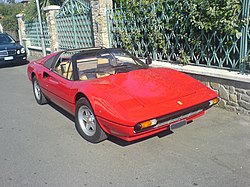 |
| Production | 1980–1985 & 1985–1986 |
|---|
| Body style | Berlinetta
Spider |
|---|
| Engine | 2.0 L V8
2.0 L turbo V8 (from 1982) |
|---|
From the mid-1970s through 1986, a small-displacement 208 was produced, generally for tax concessions within the Italian market; it was also listed in New Zealand, due to their taxes on engines above 2 litres. The 208 GTB/GTS replaced the 208 GT4 2+2 in 1980.
The engine was de-bored to 68.8 mm (giving an undersquare design) for a total of 1991 cc displacement, resulting in the one of the smallest V8 engines ever produced. The 208 produced only 155 bhp (116 kW) which meant that performance was underwhelming, especially for a Ferrari. 160 208 GTS and 140 208 GTB cars were produced in 1980 and 1981.
In 1982, turbo-charging and fuel injection increased power output to 220 bhp (164 kW), but initially only available in GTB form; the GTS turbo was introduced in 1983. In 1985, small body-style modifications were made, in-line with the introduction of the 328; production ended in 1986 after 437 GTB turbo and 250 GTS turbo cars were produced.
In 1986 they were replaced by
328-based GTB/GTS Turbo.

Two 1979 308GTBs, Euro spec (left) and US spec.
Regional differences
Among the typically yearly updates to the performance and style of the 308 throughout its run, cars from the same series would have a number of differences between them depending on their intended export market (which is usual for European cars). For example a 308 destined for the American market would sport much larger heavier bumpers and a slightly sturdier frame (and many other smaller details) in order to meet more stringent US road safety standards. American market cars also suffered a performance hit due to engine-driven 'smog pumps' to meet state emissions legislation which reduced horsepower. As a result of these differences there is often a premium paid for the "purer" European spec car over the federalized car.
Some differences between the Euro-spec and US-spec cars are shown below:
- 240 hp vs. 235 hp
- Different gear ratios
- Lighter, small front bumper that follows the hood line vs. 2.5 mph impact bumper that is extended and has extra “fangs”
- Lighter, small rear bumper vs. impact bumper with spacer
- Exposed dual tip muffler vs. black muffler cover with catalytic converter
- vitaloni style outside mirrors vs. larger flag mirrors that provide a better view for safety
- Small yellow front side marker light with no rear side lights vs. large rectangular yellow front and red rear side marker lights (many euro cars now in the USA had the euro lights converted to USA spec and added the red rear lights)
- No “fasten seat belt” warning light in Euro spec
- Flash to pass driving lights in front grill in Euro spec
- Space saver spare tire vs. full size spare
- Rear engine cover top has only a left and right grill vs. “U” shaped grill that provides a larger cooling area
- Overall weight of Euro spec lower because of door beams and bumpers.






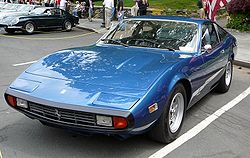

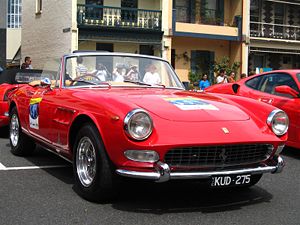


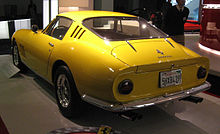
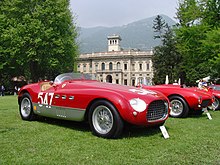







![Validate my RSS feed [Valid RSS]](valid-rss-rogers.png)














































































